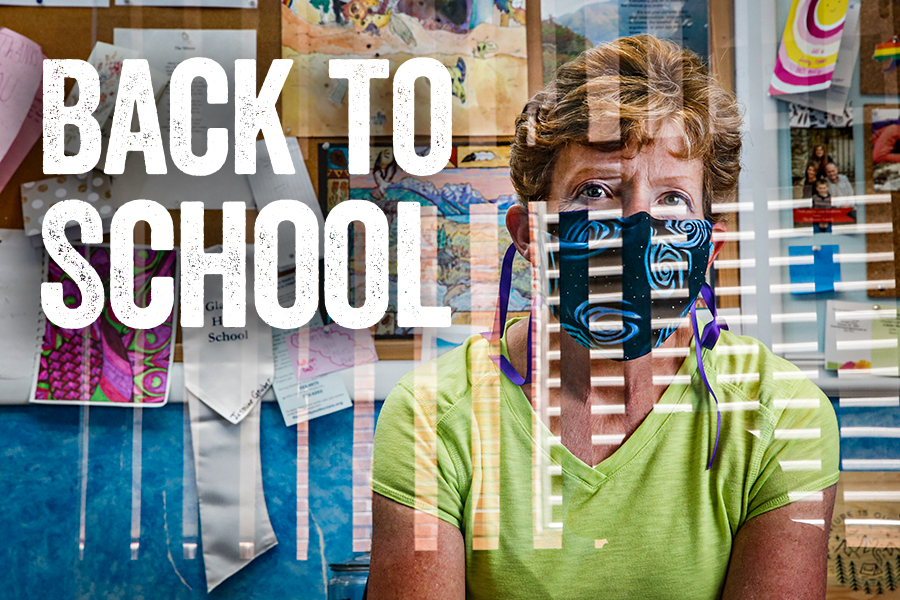School Counselors Helping Students Navigate Pandemic
From tips for expressing gratitude to coping with bad news, mental health professionals striving to stay connected with students
By Andy Viano
When students want to talk to Deb Burfeind, the head of the guidance department at Kalispell Middle School, they will do so through a piece of Plexiglas on a table in her office. When they want to talk to Susan Sherman, it will be through a clear shower curtain strung from wall to wall.
Both, however, are preferable to a computer screen.
The 2020-21 school year has arrived in Northwest Montana, and while reminders of what’s different are not hard to spot, the return to in-person learning offers guidance counselors a chance to reconnect face to face with boys and girls who are trying to navigate a worldwide pandemic in addition to their studies. And no matter how long students remain in school, counselors are taking advantage of the time they’ll get in the next several weeks.
At KMS, for example, a “universal screener” will be conducted within the entire student population to check in with the sixth, seventh and eighth graders who have been at home since mid-March. It’s one of the only ways, Burfeind believes, that she and her colleagues can quickly catch up with students who, in ordinary times, would have been able to stroll into their office anytime to share their concerns.
“Our biggest issue is that when we go online we lose contact almost immediately with the students,” she said. “We’re especially looking for those kids who internalize and don’t necessarily express their anxiety, not only over COVID but how they’re doing overall.”
When schools suddenly shut down in the spring, counselors attempted to quickly get up to speed on remote conferencing options, and to help their students do the same, with mixed results. With that experience now under their belts and the widely held belief that it is a matter of when, not if, students are returned to remote learning, at least temporarily, there is an early focus this year on getting everyone on the same page with online technology.
“We’re training the kids the first few weeks on how to do online better,” Burfeind said. “Last year, doing it online, that was a big learning curve for everybody.”
In Kalispell, virtual counseling sessions are held using Google Classroom, and Burfeind said she and her staff are exploring the option of holding open sessions, essentially walk-in hours where counselors are available to chat with students. For those who can’t meet remotely or don’t feel comfortable doing so, some counselors also made phone contact and held socially distant in-person meetings in the spring.
As for the content of those meetings, anxiety has been top of mind, and not always in a bad way. Some students who experience anxiety because of in-person stressors are reportedly doing better while learning online, but COVID-19 and coronavirus-related life changes are also the source of a great deal of anxiety for kids and adults alike. And treating those parents, Bigfork counselor Mary Ahnert believes, is one of the keys to helping her students avoid anxiety during the impending school year.
“The bottom line is, ‘How are the parents reacting?’” she said. “If the parents are all upset, then the kids are, too, because they’re kind of confused.”
Ahnert has urged her students and their parents to take advantage of the opportunities presented by the pandemic and at-home learning. Rather than stress about the news, some of her families have picked up new hobbies or learned new skills, everything from raising pigs to making cooking videos to taking virtual tours of cities, parks and museums.
“To get kids outside the box and be creative helps them,” she said. “It empowers them so they’re not feeling like they’re victims of the pandemic but that they have some power during this time. Anytime we empower kids we decrease their anxiety.”
At Kalispell Middle School, Sherman, who is counseling this year’s class of sixth graders, said her focus is on depression, especially when students return to remote learning and can more easily become isolated from important relationships with teachers and fellow students. In response, Sherman helps students learn mindfulness techniques and stay connected to the trustworthy adults in their lives.
“I think empathy, listening to where they’re coming from,” Sherman said of her approach. “And trying to give them known coping skills that work, reducing your time that you’re watching the news or you’re paying attention to it, being sure that you’re talking to trusted adults about how you’re feeling, continuing to socialize and not isolate yourself, and recognizing that your fears are real and people of all different ages are feeling them.”
In addition, counselors will be taking a close look at potential cases of abuse, especially in whatever time they have to meet with students in-person. The Child Abuse Hotline operated by the Montana Department of Public Health and Human Services (DPHHS) experienced a sharp downturn in calls during the height of the shutdown, and experts believed that had much to do with a lack of interaction with school officials, who are mandatory reporters of abuse. The DPHHS Child Abuse Hotline is (866) 820-5437.
In the end, though, there are reasons to be encouraged. Children are resilient and flexible, the counselors said, and their familiarity with social media has made it easier to maintain connections with friends. And when anxiety or depression or other trouble does strike, a counselor won’t be far away, no matter if it’s a screen or a shower curtain between them.